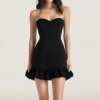Choosing the perfect name for your boutique is one of the most critical decisions you’ll make as a business owner. It’s the first impression your customers will have of your brand and sets the tone for your business. A great name can help your boutique stand out in a crowded market, convey your unique style, and attract the right clientele. Here’s a step-by-step guide to help you choose a name that encapsulates your boutique’s essence and resonates with your target audience.
1. Define Your Brand Identity
Before diving into brainstorming, it’s essential to understand your brand identity clearly. Ask yourself:
-
Who is your target audience? Are you targeting young fashionistas, professional women, or eco-conscious shoppers?
-
What is your boutique’s unique selling proposition? What sets you apart from competitors? Is it your hand-crafted items, sustainable products, or exclusive designer collaborations?
-
What are your brand values and personality? Are you classic, elegant, trendy, edgy, or cozy and inviting?
Your answers to these questions will guide your naming process by ensuring the name aligns with your brand identity. For more on defining your brand, check out this guide by HubSpot.
2. Brainstorm Keywords
Start brainstorming a list of keywords that relate to your boutique. Think broadly and consider words associated with:
-
Fashion and Style: chic, trendy, haute, vintage, couture
-
Your Product Range: scarves, shoes, dresses, accessories
-
Your Brand Values: sustainable, elegant, unique, bespoke
-
Feelings and Experiences: bliss, charm, allure, joy, delight
Write down everything that comes to mind, as this will serve as a foundation for your boutique name.
3. Create a List of Potential Names
Using your list of keywords, start combining them in different ways to create potential names. Aim for a mix of:
-
Descriptive Names: These explicitly describe what your boutique offers. For instance, “Elegant Essentials” or “Vintage Vogue.”
-
Invented or Compound Names: Combine two words to create something unique. For example, “TrendBliss” or “ChicNest.”
-
Abstract Names: Less directly tied to your offerings, abstract names can evoke a feeling or a story, like “Lush” or “Serendipity.”
-
Personal Names: Consider using your name or a variation of it if it fits your brand, such as “Ella’s Closet” or “Sophie Styles.”
Generate as many options as possible. This stage is about quantity, not quality.
4. Check for Availability
Once you have a list of potential names, it’s time to check for availability. You don’t want to fall in love with a name only to find out it’s already taken. Here’s how:
-
Domain Name: Check if the domain name is available for your boutique. Websites like GoDaddy or Namecheap can help you see if your desired URL is available.
-
Social Media Handles: Verify if the name is available on major social media platforms such as Instagram, Facebook, and Twitter. Consistency across these platforms is essential for branding.
-
Trademarks: Conduct a trademark search to ensure another business doesn’t legally protect your name. You can use resources like the United States Patent and Trademark Office (USPTO), Canadian Intellectual Property Office (CIPO) or international equivalents.
5. Test Your Name
With a shortlist of available names, test them to see how they resonate with potential customers and stakeholders. You can:
-
Survey Your Audience: Use social media polls or email surveys to ask for feedback on your top name choices.
-
Say It Out Loud: Ensure it’s easy to pronounce and memorable when spoken.
-
Visualize It: Create mock logos or business cards to see how the name looks in different fonts and designs.
6. Make It Future-Proof
Finally, consider the long-term implications of your chosen name. Think about:
-
Scalability: Will the name remain relevant if you expand your product range? A name like “Shoe Stories” might limit your ability to branch out into clothing.
-
Trends: Avoid overly trendy names that might become dated. Think classic and timeless.
-
Cultural Sensitivity: Ensure the name doesn’t have negative connotations in other languages or cultures, especially if you plan to sell globally.
Differences in US and Canada Trademark Law
Once you’ve chosen a name, it’s crucial to protect it legally. Here’s a breakdown of trademark laws in the US and Canada:
Common Law vs. Federal Trademark
-
Common Law Trademark: In both the US and Canada, you automatically gain some trademark rights by using a name in commerce, even without formal registration. However, these rights are limited to the geographic area where you operate.
-
Federal Trademark: Registering your trademark with the USPTO or the Canadian Intellectual Property Office (CIPO) provides nationwide protection and stronger legal standing.
First Use, Intent to Use, and First to File
-
First Use: In the US, trademark rights are granted to the first party to use the name in commerce. In Canada, it’s a mix of first use and first to file.
-
Intent to Use: In the US, you can file a trademark application based on your intent to use the name.
-
First to File: In Canada, the first party to file a trademark application generally has priority, even if they haven’t used the name yet.
Final Thoughts
Choosing the right name for your boutique combines creativity, strategy, and practicality. Remember, your boutique name is your brand’s first impression. Make it count. Here’s to finding the perfect name that captures the heart of your boutique and attracts the customers you desire.
Related






















































